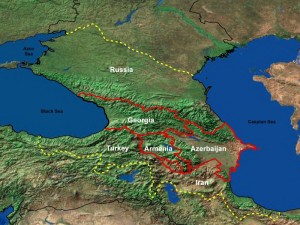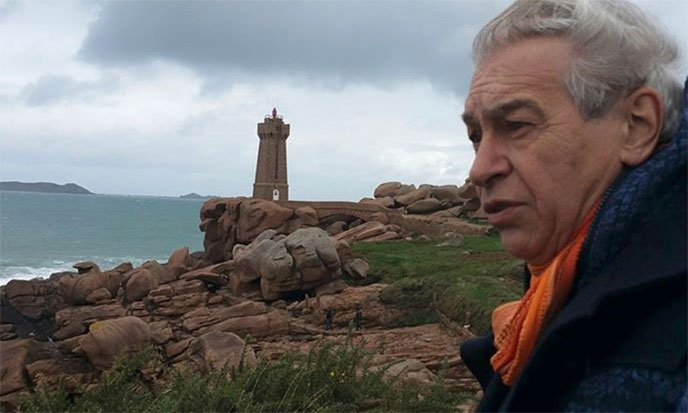Dolmens
Séguin, Xavier
Xavier Séguin (1949- ) is the French author of the Eden Saga website(a). We have encountered Séguin in Atlantipedia in relation to a number of subjects. Some of his ideas are, in my opinion, simply daft. For example, he suggests that megalithic dolmens and menhirs can generate vril energy, which can be used to expedite the maturing of wine(b)!
The most exotic suggestion regarding the Etruscans comes from Séguin, who has claimed that they share a common ancestry with the Yoruba of West Africa, as both originated in Atlantis(c), a concept ‘borrowed’ from Leo Frobenius. He also offered a most extreme theory regarding the Olmecs with the claim that they were astronauts. This idea was expressed(d) by Séguin, quoting US astronaut Gordon Cooper [1757]!
However, I considered Séguin to be totally unreliable when I found that he also quoted a fictional character, Professor Mortimer, from a work by the renowned writer, Edgar P. Jacobs, as supposedly uttered by a real scientist(e), in relation to the Pillars of Heracles.
He denies that Atlantis was situated on the floor of the Atlantic, instead he proposes that Atlantis, Punt, Mu and Hyperborea had all been satellites(f)! Similar ideas were put forward Dieter Bremer.
(a) Sources Archives – Eden Saga – english (eden-saga.com)
(c) http://eden-saga.com/en/survivors-from-atlantis-frobenius-sixteen-gods-oracle-of-fa.html
(d) http://eden-saga.com/en/gordon-cooper-finds-olmecs-deep-knowledge-in-astronautics.html
Jensen, John M. Jnr.
John M. Jensen Jnr. is an independent researcher living in Florida, who has published two books on  ancient civilisations and catastrophism. He has explored in depth some of the subjects touched on here. His first book was Ancient Canal Builders(a), which explores the extensive ancient canal network on the Atlantic and Gulf coasts of the United States and Mexico. His second offering is Earth Epochs(b) in which he recounts pre-historic global catastrophes, including the Younger Dryas Event of 12,900 YBP, and what he calls the Last Great Cataclysm of 5,000 YBP and the Earth Axial Tilt of 3448 YBP.>In a separate paper he claims that the final catastrophe led to the breaching of the Gibraltar and calendar changes among other effects.<
ancient civilisations and catastrophism. He has explored in depth some of the subjects touched on here. His first book was Ancient Canal Builders(a), which explores the extensive ancient canal network on the Atlantic and Gulf coasts of the United States and Mexico. His second offering is Earth Epochs(b) in which he recounts pre-historic global catastrophes, including the Younger Dryas Event of 12,900 YBP, and what he calls the Last Great Cataclysm of 5,000 YBP and the Earth Axial Tilt of 3448 YBP.>In a separate paper he claims that the final catastrophe led to the breaching of the Gibraltar and calendar changes among other effects.<
However, he seemed to go off the rails when he proposed that humans and dinosaurs co-existed and that the many thousands of dolmens found around the globe were not tombs but places of refuge from carnivorous dinosaurs. No, I’m not making this up. He deals with the subject in greater detail in the well-illustrated Earth Epochs(d). Both of his books can be downloaded for free.(a)(b)
Jensen does mention Atlantis, but without dealing with the matter in any great detail, it seems to me that he does accept its reality. I do not agree with all his ideas but I think his work should be read, including his blogs(c).
>In 2018, Jensen offered a possible submerged urban site “located about 130 miles west of Homestead, FL in the Gulf of Mexico. It is in the middle of the Florida Continental Shelf. Based on Google Earth measurements, (setting Google Earth coordinates to the satnav position of this image) at the same elevation, then measuring the relative length and width of this image, renders a size of some 18 miles in width and some 14 miles in breadth. Making this metropolis at least the size of Miami proper, and likely larger.” He claims that this apparent metropolis must be more than 10,000 years old, based on the rate of sea level change following the last Ice Age. He offered a link to a paper about the feature on the academia.edu website, but this is no longer there(e).<
(a) https://www.academia.edu/3779666/Ancient_Canal_Builders_-_Overview
(b) https://www.smashwords.com/books/view/536932
(c) https://earthepochs.blogspot.ie/
(d) https://www.academia.edu/11703016/Earth_Epochs_Overview
(e) Earth Epochs (Sept.18, 2018) *
Caucasus Mountains
The Caucasus Mountains lie between the Black and Caspian Seas and contain the highest mountain in Europe, Mount Elbrus (Russia). In ancient times it was the location of several kingdoms of whom two were known as Albania and Iberia.(d)>Today, they contain a small part of the Russia Federation along with the former Soviet republics of Armenia, Azerbaijan and Georgia.<
mountain in Europe, Mount Elbrus (Russia). In ancient times it was the location of several kingdoms of whom two were known as Albania and Iberia.(d)>Today, they contain a small part of the Russia Federation along with the former Soviet republics of Armenia, Azerbaijan and Georgia.<
>Delisle de Sales was probably the first to suggest the Caucasus as the home of the original Atlantis, with refugees from there establishing Plato’s Atlantis in the Central Mediterranean. However, the greatest proponent of the Caucasus location for Atlantis was R.A. Fessenden who wrote, The Deluged Civilisation of the Caucasus Isthmus, an extensive multi-volume work [1012] on the subject published early in the 20th century.<
>Regarding the Pillars of Herakles being in the Caucasus Fessenden noted “The fact that Nebuchadnezzar, after reaching them in his northern expedition, next went to the north shore of the Black Sea and to Thrace; and that Hercules, coming back from the pillars with the cattle of Geryon, traversed the north shore of the Black Sea (see Megasthenes, quoted by Strabo and Herodotus, 4.8), puzzled the ancient geographers because they thought that the Pillars were at the straits of Gibraltar. And because they had overlooked the fact that the Phoenicians of Sidon had known that the Pillars had been lost and that the Phoenicians had sent out four expeditions to look for them but had reached no conclusion from these expeditions except that the straits of Gibraltar were not the true Pillars of Hercules.” See Strabo, 2.5 (m)<
More recently, Ronnie Gallagher, an admirer of Fessenden, has studied the Caucasus region, in particular,  the hydrology of the Caspian Sea(a), where he identified strandlines up to 225 metres above sea level (ASL), which he considers to be evidence of a vast inland Eurasian sea at the end of the last Ice Age. In Azerbaijan, he also found cart ruts similar to those on Malta as well as stone circles on the Absheron Peninsula(b). Professor E. N. Badyukova has offered some critical comments regarding Gallagher’s claims(k).
the hydrology of the Caspian Sea(a), where he identified strandlines up to 225 metres above sea level (ASL), which he considers to be evidence of a vast inland Eurasian sea at the end of the last Ice Age. In Azerbaijan, he also found cart ruts similar to those on Malta as well as stone circles on the Absheron Peninsula(b). Professor E. N. Badyukova has offered some critical comments regarding Gallagher’s claims(k).
Flinders Petrie also referenced Fessenden in his (1926) paper The Origins of the Book of the Dead(f), in which he concluded “that the cultural connections of the earliest Egyptians, as well as the physical descriptions in their mythology, point to the Caucasus region. When, further, we find there the names of the principal places of the mythology in their relative positions, it gives strong grounds for regarding that region as the homeland of the earliest civilisation of the Egyptians.”
A few years later, an article by Margaret A. Murray in Antiquity (Volume 15 – Issue 60 – Dec. 1941) noted that Petrie’s “opinion was based entirely on literary and philological evidence” resulting in archaeologists being slow to accept it. To partially counter this Murray offered two pieces of evidence in support of Petrie’s proposed Egyptian-Caucasus connection.(i)
However, I must point out that in 1874 Hyde Clarke delivered a paper to the Royal Anthropological Institute in which he claimed that the Colchians in the Caucasus had been an Egyptian colony(h). Clarke also employed language similarities>and Herodotus’ Histories (Bk2.102-106)< to support his contention. So we can reasonably ask, who was right or were both Clarke and Flinders Petrie wrong?
A forum on Graham Hancock’s website offered some more discussion about an Egyptian link with the Caucasus(j).
Jean-Michel Hermans has claimed that the megalith builders of Brittany originally came from the Caucasus, and arrived there after a stop in what is now Bulgaria around 5000 BC(l),>and while there, they discovered mathematical relationships such as ‘pi’ and the ‘golden ratio’ !<
The Amazons of Greek mythology are thought by some to have originated in the Caucasus and as late as 1671, Sir John Chardin reported that a tribe of Amazons existed in Georgia. Interestingly, a 19th-century photo shows two armed ladies from Armenia captioned as ‘Amazons of Armenia 1895’.
An added mystery was offered by Alexander Braghine, who recounted that “I was present when a former Russian officer of Georgian origin found himself able to talk with the natives of Vizcaya immediately upon his arrival in Northern Spain: he spoke Georgian, but the Basques understood this language.” [156.187]
Currently, Bruce Fenton has claimed the Caucasus as the home of giants. However, Jason Colavito has demonstrated the unreliability of his claims(c).
In the Krasnodar region of southern Russia hundreds (actually 3,000 and counting) of dolmens are to be found on both sides of the Caucasus. Interestingly, they show a distinctive form of megalithic architecture(g).
I feel that the Caucasus will have a lot more to tell us.
(a) Wayback Machine (archive.org)
(b) https://www.azer.com/aiweb/categories/magazine/ai103_folder/103_articles/103_cart_ruts.html
(d) https://en.wikipedia.org/wiki/Caucasian_Albania
(f) Archive 6947 | (atlantipedia.ie)
(g) The mysterious dolmens and megaliths of the Caucasus – The Tapestry of Time (larazzodeltempo.it)
(h) https://www.jstor.org/stable/pdf/2841305.pdf
(i) Antiquity, Vol. 15, Issue 60, Dec. 1941 p.384-386
(j) New article: Observations on Late Pleistocene Flooding of the… – Graham Hancock Official Website
(k) Archive 7221 | (atlantipedia.ie)
(l) Amazon.fr
Davidiy, Yair
Yair Davidiy is an Orthodox Jewish researcher currently living in Israel. He is a leading proponent of the Brit-Am movement(a) which promotes the idea that the descendants of the Lost Tribes of Israel are to be found in Europe but more particularly in Britain and America.
descendants of the Lost Tribes of Israel are to be found in Europe but more particularly in Britain and America.
>Davidiy has also discussed the subject of Nordic Israelism(d) in a lengthy video entitled Lost Ten Tribes of Israel in Scandinavia(e).<
The Late Walter Baucum was also a Brit-Am supporter and the author of Bronze Age Atlantis[183] in which he identified the Sea Peoples as Atlanteans. Davidiy wrote the Introduction(b), generally supporting Baucum’s ideas, although he dissents somewhat from elements of Baucum’s dating. With regard to Atlantis itself, Davidy is carefully non-committal.
Davidy makes the unusual claim on the Brit-Am website that “Dolmens and Megalithic Monuments originated in Ancient Israel. Jeremiah 31:21 says that the Lost Ten Tribes will construct a trail of Megalithic Monuments from Israel to their places of exile and evidence of this path will enable them to return. Such a trail exists! It is the Trail of the Dolmens from the Middle East to the West.”(c) As far as I’m aware Davidy has not explained anywhere the huge numbers of dolmens in places such as Korea and Japan, which are in the far east!
(b) https://www.britam.org/baucumcover.html
(c) https://www.britam.org/Proof/Attributes/roleDolmen.html
Brittany *
Brittany in northwestern France is sometimes referred to as Little or Lesser Britain. It is one of the most exciting regions of Megalithic Europe. The stone rows of Carnac are unequalled, Le Grand Menhir Brisé was once the largest standing stone in Europe, while  Morbihan contains a huge number of dolmens and standing stones.2019 saw a report that “Bettina Schulz Paulsson, an archaeologist at the University of Gothenburg, reexamined some 2,410 radiocarbon dating results that have been assigned to Europe’s megaliths and put them through a Bayesian statistical analysis. Based on the picture the data presents, Schulz Paulsson believes that the megaliths were first constructed by dwellers of northwest France during the second half of the fifth millennium BC.” (b) Both Robert Hensey, who has studied and written about Newgrange [1766.6] and Mike Parker Pearson, Stonehenge’s leading, authority, have endorsed this idea of a French origin for megalith building(c).
Morbihan contains a huge number of dolmens and standing stones.2019 saw a report that “Bettina Schulz Paulsson, an archaeologist at the University of Gothenburg, reexamined some 2,410 radiocarbon dating results that have been assigned to Europe’s megaliths and put them through a Bayesian statistical analysis. Based on the picture the data presents, Schulz Paulsson believes that the megaliths were first constructed by dwellers of northwest France during the second half of the fifth millennium BC.” (b) Both Robert Hensey, who has studied and written about Newgrange [1766.6] and Mike Parker Pearson, Stonehenge’s leading, authority, have endorsed this idea of a French origin for megalith building(c).
The earliest suggestion that Atlantis may have been connected with the Armorican peninsula came from François Gidon in the 1930s when he proposed that Atlantis had been situated on an exposed Celtic Shelf stretching from Brittany to Ireland. Unfortunately, he dates the submergence of this land to between 3000 and 1200 BC, which was millennia after that part of the Celtic Shelf had been inundated by the Flandrian Transgression.
Jean Markle was convinced that the Carnac stones were connected with Atlantis. Recently, Sylvain Tristan followed the work of Jean Deruelle in supporting a megalithic Atlantis. Further support has come from Alfred deGrazia and Helmut Tributsch who saw Megalithic Europe as Atlantis with the island of Gavrinis in Brittany as its capital.
The American researcher, Hank Harrison, considers the Morbihan départment as a significant Atlantean location if not the home of its capital.
Reinoud deJonge proposes even greater significance for the Brittany megaliths with his claim that they record the Flood of Noah in 2344 BC(a).
A fairly lengthy illustrated paper regarding ancient catastrophes in Brittany is available online(d).
(a) See: Archive 2501

